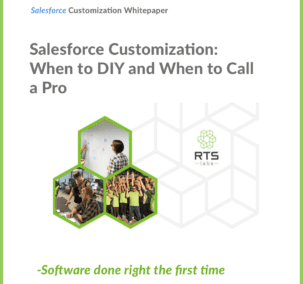Why Your Salesforce Is Failing the Grade: Part 1

Are you not getting the results you expected from Salesforce? Does your customization not meet your business requirements? Is your data low quality? Is no one using your Salesforce?
If you’re experiencing any of these problems – to the point that they’re interfering with your daily operations and your Salesforce ROI – then your implementation could be why your Salesforce is failing the grade.
Some high school students can’t get into college because they don’t have good enough grades. In the same sense, flunking your Salesforce implementation has a negative impact on your future business results. There are many ways to end up with low grade results, too.
Want to know where you stand? Give yourself a Salesforce report card by following these steps, and learn where you can still make improvements.
1. Engaging in the discovery process
Did you start your implementation with an open mind and look into all the possible ways you could use Salesforce? If so, were your options for getting an immediate ROI considered? Did you think through the larger, long-term challenges you want to solve and match any customization of Salesforce to your challenges and needs? If not, you may have short changed yourself by not fully engaging in the Salesforce discovery process upfront, leaving you without as strong of a foundation for all the other implementation steps. And then, you may be drawing a blank when it’s time to set your goals.
2. Setting Salesforce goals
If you set a clear direction for Salesforce, did you take the next step of writing down specific, measurable goals? If so, were those goals aligned with your business requirements versus being part of some canned, one-size-fits-all solution? (You know how we feel about one-size-fits-all solutions at RTS Labs.) Not aligning your Salesforce goals with your business requirements puts you at risk of realizing at the end of your implementation process that you need to change direction – which means you’ll have to go back to the beginning and revisit your goals.
3. Determining what reporting is needed
What questions did you ask about the metrics you would need before you began developing your reporting tools? For example, if you were implementing Sales Cloud, did you determine what your salespeople must be accountable for and what managers must be able to report on? What about the dashboard for your executive decision makers? If you didn’t think ahead to what your day-to-day reporting needs would be, your data is at risk of being low quality.
4. Building your implementation team
If you did the implementation yourself, did you have all the technical resources you needed, such as project managers, business analysts and developers? Was there at least one stakeholder involved in the process? Did you have a qualified System Administrator and power users involved each step of the way? Having any of these groups underrepresented during implementation can ultimately contribute to a failing grade. Their insights into day-to-day uses and needs of Salesforce can be invaluable as you set up Salesforce and roll it out.
5. Defining and prioritizing milestones
Were milestones created so you could track your progress as you went through your implementation? Did you get buy-in from your team and gather their input on what they’d like to see? Did you give them feedback on how their suggestions would be used? Did your milestones include how end-user training would fit into your rollout plan? If not, you may end up with two problems. First, failing to get buy-in and suggestions from the people who will ultimately be using Salesforce usually leads to low adoption rates of the system. That alone can cut your Salesforce ROI nearly in half. Second, without trackable milestones, you’ll have no idea where you stand as you progress through implementation and into daily use.
How to Get an A+ in Salesforce
There are many ways a Salesforce implementation can go wrong. Give yourself 10 points on your Salesforce report card for each step you did correctly. Anything less than 50 points so far and you’ll be getting less than an A+, meaning your Salesforce may not be performing as well as it could be.
The good news is that if your Salesforce isn’t working right, you don’t necessarily have to repeat your entire implementation to correct things. With the right advice, you may only need a few tweaks to go from a C- to top of the class.
Want to graduate with honors in Salesforce results? Consider having a conversation with our Salesforce subject matter experts at RTS Labs, and stay tuned for part 2 of “Why Your Salesforce Is Failing the Grade” to get your final grade.
In the meantime, enjoy this complimentary whitepaper, “Salesforce Customization: When to DIY and When to Call a Pro.”
